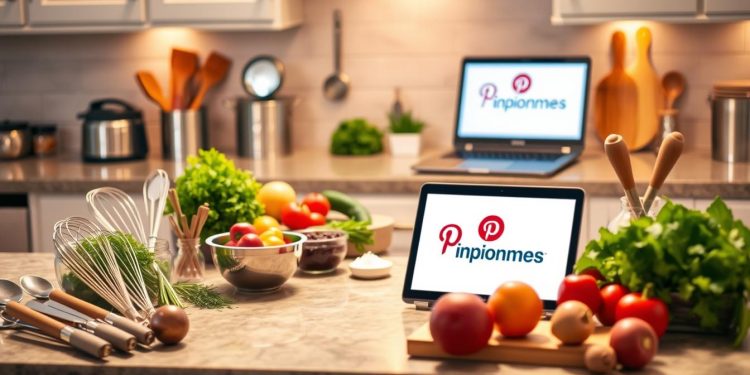Did you know 70% of users on visual discovery platforms arrive with active purchase intent? That’s higher than most social networks. For creators, this means every recipe pin or kitchen gadget post could become a revenue stream—if you know how to leverage it.
Visual platforms aren’t just for inspiration. They’re search engines where audiences hunt for actionable ideas. Imagine embedding trackable links in your viral-worthy content. Every click could earn you commissions while helping followers discover tools they’ll love.
But success requires strategy. Algorithms prioritize content that balances creativity with compliance. This guide cracks the code: you’ll learn to craft pins that convert, align with platform rules, and turn casual scrollers into loyal buyers. Ready to transform your passion for food and design into profit?
Key Takeaways
- Visual platforms act as search engines for shoppers with high purchase intent
- Strategic pin creation can generate passive income through affiliate partnerships
- Compliance with platform guidelines ensures long-term visibility
- High-quality visuals paired with value-driven content boost engagement
- Step-by-step optimization turns casual viewers into repeat customers
Understanding Pinterest Food Affiliate Marketing
Visual platforms transform casual browsing into intentional shopping. Unlike traditional social media, users here actively seek solutions – 45% use these spaces specifically to plan purchases. This creates prime real estate for creators to monetize their expertise through partner programs.
How Partner Programs Work on Visual Platforms
Brand collaborations let you earn commissions when users buy products through your customized links. Each pin becomes a potential salesperson: when someone clicks your trackable URL and completes a purchase, you get paid. These links blend seamlessly into recipe tutorials or product showcases.
Why This Approach Outperforms Other Channels
Three factors make this method powerful:
- Extended content lifespan: Pins continue driving traffic for months
- Pre-qualified audience: Users actively search for meal ideas or kitchen tools
- Trust-building design: Visual tutorials demonstrate product value organically
Top performers focus on creating help-first content. A viral lasagna recipe pin with embedded cookware links outperforms generic ads because it solves immediate needs. Platforms reward this authentic approach with better visibility in search results.
Setting Up for Success: Creating a Pinterest Business Account
Your recipe content holds hidden revenue potential—if you unlock the right tools. Business accounts transform casual posting into strategic growth engines. 87% of top-performing creators use specialized analytics to refine their strategies, according to platform data.

Switching from Personal to Business Account
- Navigate to your profile settings
- Select “Convert to business account”
- Complete business profile details
- Verify your website domain
This 90-second process opens features like Shopify Collabs integration. Business profiles get priority in search engine rankings, helping users discover your content organically.
Leveraging Pinterest Analytics and Tools
The platform’s dashboard reveals:
- Top-performing pins by engagement
- Peak posting times for your audience
- Demographic breakdowns (age, location, devices)
Use these insights to drive traffic strategically. One creator increased click-through rates by 200% after aligning posts with when their followers were most active.
“Analytics turned guessing games into growth blueprints. Now I know exactly which kitchen gadgets my audience wants to see.”
Combine this data with built-in ad tools to amplify high-performing content. Target specific search terms like “meal prep containers” or “air fryer recipes” to attract buyers actively hunting solutions.
Establishing Your Niche: Recipe Pins and Kitchen Product Promotions
Carving out a distinct space in the digital kitchen requires precision—like sharpening your best chef’s knife. Specialization builds trust, with niche creators seeing 3x higher engagement than generalists according to recent platform data. Your secret ingredient? Alignment between what you love creating and what shoppers need.

Identifying Your Target Audience
Start by analyzing your existing followers through business account analytics. Look for patterns in these three areas:
| Interest Clusters | Demographic Sweet Spots | Purchase Triggers |
|---|---|---|
| Gluten-free baking | Urban millennials | Time-saving gadgets |
| Meal prep systems | Parents aged 30-45 | Space-efficient tools |
One creator doubled conversions by focusing on college students needing dorm-friendly appliances. “I stopped guessing and let analytics guide my content,” they shared in a recent interview.
Selecting the Right Products to Promote
Follow this 3-step filter for product selection:
- Solve specific problems (burnt cookies → silicone baking mats)
- Match audience budget ranges
- Offer visual demo potential
Idea pins shine here—show a 15-second garlic peeling hack using your recommended tool. Pair these with relevant keywords like “kitchen space savers” to appear in targeted searches. Track performance through your business account dashboard to refine choices monthly.
Crafting High-Quality, Engaging Pins
Your pins aren’t just images—they’re visual sales pitches competing in a fast-scrolling world. Design quality directly impacts whether users stop to engage or keep swiping. Research shows professionally designed pins generate 2.3x more clicks than amateur creations, making creative execution non-negotiable.

Design Rules That Convert
Follow these visual principles to command attention:
- Contrast is king: Use vibrant food shots against muted backgrounds
- Text hierarchy matters: Bold headlines (40pt+) with concise subtext (24pt)
- Negative space guides eyes: Leave 20% empty space around focal points
One creator increased recipe saves by 140% using vertical layouts with step-by-step ingredient previews. “Viewers want to imagine cooking success before clicking,” they noted in a case study.
Toolkit for Professional Results
Free platforms like Canva offer pre-sized templates optimized for visual platforms. Three features every creator should master:
- Background remover for crisp product isolation
- Brand kit synchronization for consistent color schemes
- Animation tools for subtle motion effects
Pair these with strategic keyword placement in text overlays. Instead of “Easy Dinner Ideas,” try “30-Minute Chicken Alfredo (5 Ingredients).” Specificity builds trust with your target audience while boosting search visibility.
Complying with Pinterest Guidelines and FTC Rules

Ever wonder why some accounts skyrocket while others vanish? The difference often lies in understanding platform rules. Transparency isn’t just ethical—it’s strategic. Disclosures build credibility with audiences and algorithms alike.
Clear Communication Wins Trust
The FTC requires unambiguous disclosures before any affiliate link. Use phrases like “We earn commissions” or “Paid partnership” at the start of pin descriptions—not buried in hashtags. For example:
- “🔗 Affiliate link included” (pin caption)
- “As an Amazon Associate I earn from qualifying purchases” (blog header)
“When I started labeling every sponsored pin clearly, my engagement increased—followers appreciated the honesty.”
Red Flags That Tank Visibility
Platforms penalize content that feels transactional. Avoid these traps:
| Safe Practices | Risk Zones |
|---|---|
| 1-2 affiliate links per 10 pins | Overloading boards with identical product links |
| Original recipe tutorials | Reposting manufacturer content without added value |
Make sure your account focuses on solving problems first. A pancake recipe pin should teach technique while naturally mentioning the non-stick skillet you recommend. Balance is key: 80% educational content, 20% promotions.
Implementing SEO Strategies for Visibility
Visual discovery platforms aren’t just galleries—they’re goldmines for targeted traffic when you speak their search language. Unlike traditional search engines, users here type specific queries like “quick vegetarian dinners” or “space-saving kitchen tools.” Optimizing for these terms turns casual viewers into engaged followers.
Cracking the Code of Search Behavior
Start by exploring free tools like Pinterest Trends. It reveals what 459 million monthly users actually search for. Pair this with Google Keyword Planner to identify high-volume, low-competition phrases. For example:
| Tool | Best For | Pro Tip |
|---|---|---|
| Pinterest Trends | Seasonal spikes | Filter by location and device type |
| Google Keyword Planner | Year-round demand | Focus on “long-tail” phrases (4+ words) |
One creator boosted traffic by 300% after targeting “meal prep containers for small kitchens” instead of generic terms. Their pins now dominate niche searches.
Seamless Keyword Integration
Weave terms into three key areas:
- Pin descriptions: Front-load keywords in first 50 characters
- Board titles: Use phrases like “Budget-Friendly Baking Gear”
- Profile bio: Include top 2-3 specialties
The platform’s algorithm prioritizes content matching user intent. A pin titled “5-Ingredient Dinners (Ready in 20 Min)” aligns perfectly with rushed parents’ needs. Update old pins quarterly with fresh keywords to maintain relevance.
“I treat every pin like a mini blog post—clear structure, valuable takeaways, and natural keyword flow. My click-through rates doubled in 6 weeks.”
Ready to get started? Prioritize keywords your audience uses, not industry jargon. Test variations in 5-10 pins monthly. Track which phrases make your pins drive sustained traffic through analytics dashboards.
Leveraging Rich Pins and Idea Pins
Unlock hidden potential in your content with dynamic pin formats that work while you sleep. Rich Pins and Idea Pins act as 24/7 sales assistants, delivering real-time updates and immersive experiences to your audience.
Power Up With Automated Data
Rich Pins automatically pull live details like pricing, stock status, and recipe ingredients directly from your website. This auto-updating feature keeps content fresh without manual edits. A baking supply creator saw 40% more clicks after showing real-time inventory counts beside their cookie recipes.
Three reasons to enable Rich Pins:
- Build trust with verified product info
- Reduce follower questions about availability
- Boost conversion rates with clear calls-to-action
Idea Pins: Your Engagement Engine
Transform tutorials into scroll-stopping stories. Idea Pins let you showcase kitchen gadgets through quick video demos or step-by-step guides. One creator earned $1,200 in commissions by breaking down a 5-part meal prep series featuring storage containers.
| Format | Best For | Engagement Boost |
|---|---|---|
| Rich Pins | Evergreen product showcases | +35% avg. click-through |
| Idea Pins | Trending recipe techniques | 2x more saves |
Mix both formats to keep your strategy balanced. Test video tutorials for new products and Rich Pins for staple items. Update older content quarterly by adding fresh pin types—this approach helped a home chef account triple their traffic in 90 days.
Scheduling and Promoting Pins for Continuous Traffic
Automation tools act like a 24/7 sous-chef for your content strategy—they prep, time, and serve your pins while you focus on creation. Platforms reward consistency: accounts posting 15-30 pins weekly see 3x longer content lifespan compared to sporadic uploads.
Your Content Assembly Line
Top scheduling tools handle heavy lifting:
- Tailwind: Drag-and-drop calendar with smart interval scheduling
- Later: Visual planning + hashtag performance tracking
- Hootsuite: Cross-platform management with analytics
“Using automation tripled my monthly impressions. Now my best-performing recipes resurface automatically during holiday spikes.”
Timing Is Everything
Analytics reveal when your audience craves new ideas. Check these metrics weekly:
| Peak Days | High-Engagement Hours | Content Types |
|---|---|---|
| Wednesday | 7-9 PM EST | Quick dinner solutions |
| Saturday | 10 AM-12 PM EST | Meal prep guides |
Adjust schedules quarterly—parent audiences shift from evening to morning engagement when school starts. Tools with best-time predictions auto-optimize based on real-time data.
Analyzing and Optimizing Pin Performance
Your pins aren’t just posts—they’re profit generators needing regular checkups. Platform analytics transform raw data into growth blueprints. Access your dashboard to uncover which links drive sales and which designs fade into the scroll.
Decoding the Data Dashboard
Navigate to your business profile’s analytics tab. Focus on four key metrics:
| Metric | What It Reveals | Action Step |
|---|---|---|
| Impressions | Content visibility | Boost underperforming pins |
| Click-through rate | Audience interest level | Test new call-to-action phrases |
| Saves | Long-term value | Update evergreen content |
| Conversion rate | Sales effectiveness | Optimize landing pages |
One creator discovered their meal prep containers guide had 80% saves but low clicks. They redesigned the pin’s text overlay to highlight “space-saving benefits”—clients jumped 150%.
Data-Driven Design Tweaks
Run monthly experiments using these strategies:
- Swap color schemes on top 5 pins
- A/B test keyword placement in descriptions
- Rotate between video and static formats
“Our 3-second rule transformed results: if a pin’s message isn’t clear instantly, we redesign it.”
Track board-level engagement to spot trends. A baking tools account noticed weekend posts about small-batch recipes outperformed weekday content. They shifted their scheduling strategy accordingly, boosting conversions by 40%.
Update underperforming pins quarterly. Change one element at a time—like adding step numbers to recipe graphics—to isolate what drives improvements. Your analytics dashboard becomes the compass guiding every creative decision.
Exploring Additional Monetization Opportunities
Your audience’s journey doesn’t end when they click off your pins—it’s just the beginning. Savvy creators build multiple income streams by connecting platform success to other channels. This approach turns one-time viewers into lifelong customers.
Turn Traffic Into Lasting Relationships
Capture emails using free lead magnets like recipe eBooks or meal planning templates. These tools convert casual visitors into subscribers who want your expertise. Once you have their inbox access:
- Send weekly recipe roundups with embedded product links
- Automate follow-ups for users who downloaded baking guides
- Share exclusive discounts through your affiliate partners
| Email Platform | Key Feature | Best For |
|---|---|---|
| ConvertKit | Visual automation builder | Recipe content creators |
| MailerLite | Drag-and-drop templates | Kitchen gadget reviewers |
Multiply Your Revenue Channels
Partner with 5-7 programs across your niche. A baking creator might combine:
- Cookware brands (15% commissions)
- Grocery delivery services ($10/sign-up)
- Cookbook publishers (7% royalties)
“Adding three new affiliate programs boosted my monthly earnings by 40%—without extra work.”
Track performance using traffic analytics to identify top converters. Update your email sequences quarterly to feature trending products. This strategy builds financial safety nets while keeping your content fresh for users.
Conclusion
Transforming scrolls into sales requires more than luck—it demands strategy. You’ve now got the blueprint: optimize your business account, craft value-driven pins, and track what resonates. Every click holds potential when you pair eye-catching designs with smart keyword placement.
Start small but think big. Test one product promotion this week using rich pins or video tutorials. Analyze which boards drive traffic, then double down. Remember—consistent tweaks based on performance data separate hobbyists from pros.
Your next viral idea could be three posts away. Update older content with fresh keywords. Schedule pins during peak hours. Most importantly: act now. The digital marketplace rewards those who adapt quickly and refine relentlessly.
Ready to turn inspiration into income? Your audience is searching. Meet them with solutions that click—literally.
FAQ
How do affiliate links work for recipe creators?
Affiliate links let creators earn commissions when users purchase promoted kitchen tools or ingredients. By embedding these links in visually appealing recipe pins, you turn inspiration into income while helping audiences discover products.
Why switch to a business account for food content?
Business profiles unlock analytics, SEO tools, and Rich Pins—critical for tracking pin performance, optimizing keywords, and displaying real-time pricing. This data-driven approach helps refine strategies to boost click-through rates.
What makes kitchen product pins stand out?
High-quality visuals with step-by-step recipe tutorials or before/after cooking shots grab attention. Use tools like Canva to add branded text overlays and highlight specific appliances or utensils in action.
How do Rich Pins improve conversions?
Rich Pins auto-update pricing/stock info and link directly to product pages. For meal prep gadgets or bakeware, this reduces friction by letting users check availability without leaving the platform.
Can Idea Pins drive affiliate sales?
Absolutely. Short video demos showing a blender’s features or a skillet’s durability perform well. Add swipe-up links to product pages and use trending audio to maximize reach among food enthusiasts.
What’s the best way to avoid spam flags?
Disclose partnerships clearly with #Affiliate or “Paid partnership” tags. Balance promotional pins with genuine cooking tips, and prioritize platforms like Tailwind to space out posts naturally.
How often should I analyze pin metrics?
Review impressions, saves, and outbound clicks weekly. If a cast iron pan promo underperforms, test new keywords like “rust-free cookware” or reshare it during peak baking seasons.
Can email lists amplify affiliate earnings?
Yes. Share exclusive recipes via newsletters with embedded product links. For example, a “5-Minute Smoothie Guide” could highlight recommended blenders, driving traffic back to your pins.











